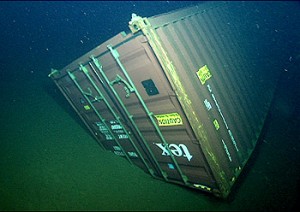Monterey Bay Aquarium Institute -
ou would have thought a disaster like this would have made the national news. But no one was hurt, and there is no legal requirement for shipping companies to report such losses. No government officials knew about this debacle except perhaps a few customs inspectors.
Following up on MBARI’s discovery, sanctuary staff investigated the potential for recovering the other missing 14 containers. However, they soon discovered that it was unlikely that the additional containers would ever be located, and the cost and time involved in recovering them would have been prohibitive. On July 26, 2006, after a significant legal effort, the shipping company agreed to pay the National Oceanic and Atmospheric Administration $3.25 million to settle claims relating to the lost containers. Money from this settlement is being used to fund the upcoming research dives.
Leading the dives are Andrew DeVogelaere, research coordinator at the MBNMS, and James Barry, a senior scientist at MBARI. Using MBARI’s research vessel Western Flyer and the remotely operated vehicle Doc Ricketts, the team will take a close look at the container itself, as well as the seafloor around the container.
Marine biologists will count the number of deep-sea animals on and around the container, and collect samples of sediment at various distances from the container for biological and chemical analysis. By comparing animal communities close to and away from the container, the researchers hope to determine what effects (if any) the container has had on seafloor life.
According to the U.S. Customs manifest, the container discovered by MBARI holds 1,159 steel-belted tires. Other containers that fell overboard held cyclone fencing, leather chairs, and mattress pads.
This motley list underscores the fact that much of the everyday merchandise we buy in stores has been shipped to the U.S. by container ship. Approximately 90 percent of worldwide non-bulk cargo travels by container ship, and between five and six million containers are in transit at any given moment. To make matters worse, not all container cargo is inert. Perhaps 10 percent of shipping containers carry household and industrial chemicals that could be toxic to marine life.

Posted via http://batavia08.posterous.com batavia08's posterous
.jpg)
No comments:
Post a Comment